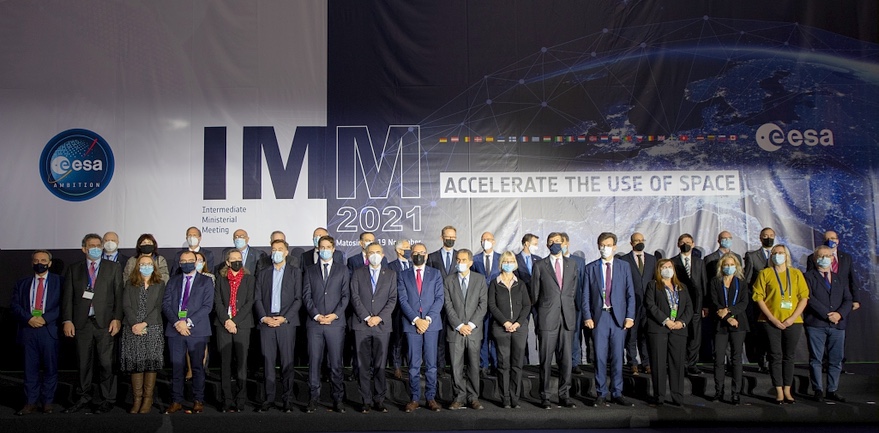WASHINGTON — The member states of the European Space Agency have endorsed a strategy to support work on terrestrial and space safety issues while also planning for future space exploration projects.
A resolution approved by ESA’s Council of Ministers at its Intermediate Ministerial Meeting Nov. 19 backed a plan, published by the agency in October, for working on three “accelerators” in climate, crisis response and protection of space assets, as well as two “inspirators” in human spaceflight and planetary exploration.
“The most important issue today was a clear and unanimous agreement to mandate to the director general of ESA to hold the necessary negotiations among member states to make these ideas and this vision possible,” Manuel Heitor, chair of the meeting and minister for science and technology in the Portuguese government, said in a briefing after the meeting.
The agreement comes in the form of a resolution called the “Matosinhos Manifesto” after the Portuguese city where the meeting took place. The brief document formally endorsed concepts outlined in a report in October by a high-level advisory group to ESA Director General Josef Aschbacher.
Those concepts include three near-term accelerators intended to speed up work on what that report called “major societal challenges” where space solutions are underutilized. One, called “Space for a Green Future,” involved greater use of satellites to address climate change, including goals in Europe to reach net-zero emissions of greenhouse gases by 2030. That concept emerged as the highest priority at the meeting.
A second accelerator, “Rapid and Resilient Crisis Response,” examines greater use of space capabilities to respond to natural disasters and other crises, including those like wildfires and floods linked to climate change. A third accelerator, “Protection of Space Assets,” would focus on addressing orbital debris and space weather threats to space assets.
“What we want to offer is that we do use space for the needs of society, putting the user at the center and making sure that we are accelerating the use of space,” Aschbacher said at the briefing.
The manifesto also endorsed two longer-range inspirators. One is a European role in human space exploration, such as developing its own ability to launch astronauts. The second is a proposal for a mission to an icy moon in the outer solar system to collect samples and return them to Earth.
While the manifesto and the report outline the general concepts, they are short on specifics, including the types of missions needed to implement them, spending levels, and roles for the European Union and international and commercial partners.
“What I have got through the Matosinhos Manifesto is a mandate to now work, building up these accelerators and inspirators,” Aschbacher said. “That means to define what needs to be done, who can contribute what and what are the overall frameworks for how these are being implemented.”
“Now we have got a starting shot to define them, to prepare them, but, of course, many questions of what exactly it means and how much they cost, and all these elements, will need to come over the next months,” he added. “This is not a trivial exercise, as you can imagine.”
The first opportunity to build up those plans will come in February at the European Space Summit, a meeting of both EU and ESA member states in Toulouse, France. Aschbacher has been promoting this meeting for months as an opportunity for the two entities to define future flagship projects that could be jointly tackled by them.
Aschbacher notes that the summit is a “political meeting, not a budget meeting,” meaning that countries won’t be committing funding for projects like those in the accelerators and inspirators. ESA, though, is also preparing for its next ministerial meeting in November 2022, where member states will make financial commitments for ongoing and future projects.
The ESA Intermediate Ministerial Meeting came days after Russia tested an anti-satellite weapon, creating thousands of new pieces of debris. That incident underlined the importance of the space safety accelerator, Aschbacher said. “What became clear is there’s an urgency to act, an urgency to make sure we find a European common way forward.”
That doesn’t mean that initiative will be further accelerated, though, he added. “Certainly it’s something we’ll take very seriously, but as you can imagine, concrete actions and who is doing what will be the subject of discussion.”
ESA also contemplates different approaches to advancing the two inspirators. Aschbacher said he will ask ESA’s director of science to develop a proposal for carrying out an icy moon sample return mission within ESA’s science program but also explore international cooperation, particularly given its anticipated high cost.
For human space exploration, he said ESA will work on “the different boundary conditions and bring this back to our decision makers for reflection and eventually a decision one way or another on how we proceed.” Proceeding with a human spaceflight program is “a clear political decision,” he said, unlike the icy moon mission that fits within ESA’s existing science framework.
